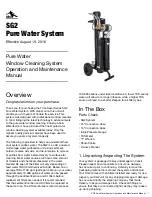
Installation
7
INSTALLATION (Typical): Common Discharge
Risk of electrical shock. Can shock, burn, or kill.
Unplug the primary sump pump before beginning this
procedure.
NOTICE:
Allow for over lap when cutting piping and run a trial
(dry) fitting before you glue.
NOTICE:
If there is no check valve in the primary sump pump’s
discharge, you will need to install one. You must also install one
in the BBU’s discharge pipe (Figure 3, Page 4). Make sure that
the check valve flow arrow points AWAY from the pump it is
protecting.
1.
Use PTFE pipe thread sealant tape on male ends of
discharge pipe. Thread the 1-
1/4” x 1
-
1/2” elbow (supplied)
onto the discharge. When tight, the elbow must point up.
2.
If possible, position the BBU on the floor of the sump; be
sure that the two pumps do not touch each other and do
not interfere with switch operation.
NOTICE:
If debris or
gravel is present in the bottom of the sump pit that could
get sucked up into the pump, set both the primary sump
pump and the BBU up on bricks or cinder blocks to prevent
clogging.
3.
If the sump is too small to allow both pumps to sit on the
bottom of the sump, find a raised position that doesn’t
interfere with the PSP switch.
4.
Cut a piece of 1-
1/2” PVC pipe to rea
ch from the backup
pump discharge elbow to about one (1) foot above the
basement floor. This is the lower discharge pipe.
5.
To prevent airlocking the pump during operation, drill a
1/8” hole in the lower discharge pipe about 2” above the
bottom of the pipe (below floor level).
6.
Install FP0026-10 check valve (purchase separately) on the
upper end of the pipe. Tighten the hose clamps securely.
BE SURE that the flow arrows point UP (away from the
backup pump). If they point down, the valve will not pass
water and the pump will not work.
7.
Cut the discharge pipe for the primary sump pump (PSP)
above the union and check valve (if any). Make this cut
about 18” above the top of the BBU’s riser pipe with the
backup pump sitting as installed.
8.
If the PSP does not have a check valve installed in the
discharge pipe, install one now.
9.
Cut a length of discharge pipe for the PSP to fit between
the check valve and a 45° slip wye. Be sure to allow for the
overlap needed for gluing joints.
10.
Install the 45° wye on the PSP’s discharge pipe.
11.
Install a 45° elbow on the 1-
1/2” BATTERY BACKUP
discharge pipe.
NOTICE:
You may need to insert a piece of straight pipe
between the elbow and the wye. If so, use a standard 45°
elbow. If you do not need to insert a piece of straight pipe
between the elbow and the wye (elbow goes directly into
the wye), use a 45° slip street ell.
12.
Fit the upper discharge pipe to the upper end of the wye.
NOTICE:
It is good practice to cut a short length of pipe to
go into the wye and install a union on the pipe. Continue
the discharge pipe from the outlet side of the union. This
will allow easier removal of the system for cleaning or
service. A U74-68 Hose and Clamp Assembly can be used
for this.
13.
Make sure that the BBU will clear the primary sump pump
and its switch. If there isn’t room
for both pumps to sit on
the floor of the sump, the BBU will have to be raised
(depending on your particular situation).
14.
Do a trial assembly to make sure that everything is going to
fit. This may require a helper to assist in holding everything
together while you check the fit without glue. Mark all
joints before gluing.
Risk of fire and chemical inhalation.
Follow the
glue manufacturer’s instructions regarding fire hazards and
ventilation when using PVC solvents, primer, and cement.
15.
Take all the pipe apart, clean all joints, and then
reassemble the system, gluing it with PVC primer and glue.
16.
Install the Battery Backup Switch as shown, 1” above start
water level of primary pump. Fasten it to the pipe with the
cable ties provided.
17.
Tape the pump cord to the riser pipe so that the plug
cannot fall into the sump.
18.
Go to “BBU WIRING AND SETUP” (Page 8) for wiring
instructions.
19.
Once all wiring is complete, fill your pit with water and
verify that the PSP removes the water and the BBU doesn’t
run. Then, unplug your PSP and refill your pit with water.
Verify that the BBU pump removes the water.
20.
Make sure that the power is on to both pumps, and your
system is ready to use.



































